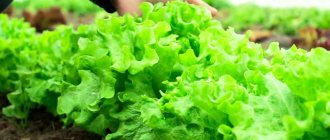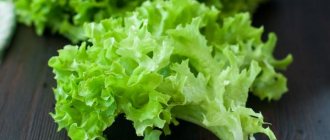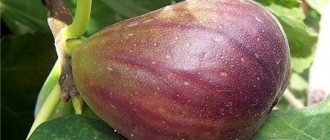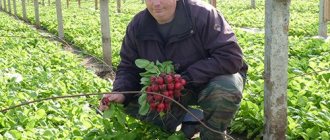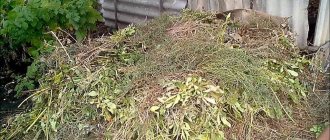Methods for sowing seeds in a garden bed
You can easily get this salad at your dacha.
To grow beautiful heads of cabbage with elastic, succulent leaves, you should follow simple rules for soil preparation, sowing seeds and care. The area where the vegetable is supposed to be grown must be well lit and not swampy. The soil must be neutral or alkaline.
If the soil is highly acidic, it is necessary to alkaline it. To do this, you can use dolomite flour, limestone, slaked lime, chalk, peat, ash or any other available component.
Ice lettuce is grown in seedlings or by sowing seeds in an open garden bed. Sowing is done in spring or autumn, and the seedling method is used only for spring planting of crops.
Pre-winter sowing of seeds
To get an early harvest of lettuce in the country, they often resort to the winter method.
The area where it is planned to grow vegetables should be dug up and organic or mineral fertilizers added to the soil.
It is important that their composition is rich in nitrogen, phosphorus, and potassium. It is better to use complex fertilizers that also contain various microelements.
When fertilizing the soil, you should follow the recommendations of the fertilizer manufacturer.
For better heating, the bed should be laid on a slightly elevated place or raised it yourself. It is recommended to sow the seeds a little thicker than usual, as it may turn out that not all of them will sprout. It is better to cover the crops for the winter with peat or leaves of fruit trees, which can always be found at a country house.
In the spring, when the crops sprout, you need to loosen the soil, remove weeds and thin out the sprouts. It is better to do thinning in two steps: when the first three true leaves appear, preliminary thinning, and after two to three weeks, final thinning.
Spring sowing
When sowing in spring, you need to prepare the soil in advance, following the same recommendations as for winter sowing.
You need to plant the seeds in the ground as soon as the snow melts. The planting depth should not be more than 1 cm. To obtain earlier germination, the crops can be covered with film. With the emergence of seedlings, it can not be removed until the air temperature reaches 15-17 0 C, but airing should be done regularly.
Growing greens in a greenhouse
Since head lettuces do not like too high temperatures, growing iceberg lettuce at the dacha in a greenhouse is recommended only in late autumn, early spring, or in winter if there is a heated greenhouse.
In general, lettuce is a cold-resistant plant, but sowing seeds is necessary when there is no threat of severe frost. It is optimal that the temperature inside the greenhouse does not fall below 40C. Immediately before planting, the soil in the greenhouse should be prepared - thoroughly dug up, adding humus and mineral fertilizers. In addition, it is worth considering that lettuce does not tolerate acidic soils. Therefore, if the soil acidity is high, it is necessary to reduce it. This can be done by adding ash and lime to the ground. But in this case you need to be careful with nitrogen-containing fertilizers, since head lettuces are nitrate accumulators.
Video about growing greens in a winter greenhouse
Before sowing, you will also have to loosen the soil, removing from it all large earthen lumps and stones that will impede germination. It is recommended to soak the seeds for a day before planting, which has a positive effect on the appearance of sprouts. Sowing of seeds is carried out to a depth of about 1 cm, the distance between rows is 30-40 cm. The planting site must be thoroughly watered and covered with agrofibre or film to retain moisture. Periodically, before emergence, the covering material should be removed to allow ventilation. These measures are a preventive measure against powdery mildew and rotting of the young plant. After the emergence of seedlings in the greenhouse, the plantings must be thinned out, leaving one plant every 30 cm.
In order for iceberg lettuce to set into heads and gain sufficient weight, it is recommended to carry out the following plant care actions:
- Timely watering. Head lettuces do not tolerate drought well, so you need to carefully ensure that the soil is always moist. You can reduce watering after the heads of cabbage have set.
- Loosening. The first loosening and removal of the earthen crust is carried out after three weeks from the moment of sowing the seeds. Next, the soil should be loosened after each watering, which will avoid rotting of the plant roots.
- Removing weeds.
After the emergence of seedlings in the greenhouse, the plantings must be thinned out.
- Feeding. When growing, it is worth regularly applying complex fertilizers, which will allow the plant to receive sufficient amounts of potassium, magnesium, phosphorus, and nitrogen.
The ripening period for iceberg lettuce is 45-80 days from the date of sowing the seeds.
Iceberg salad - simple, tasty, juicy!
The first place in the ranking of the most popular varieties of lettuce in the world rightfully belongs to Iceberg, whose homeland is considered to be Egypt.
Visually, Iceberg lettuce resembles small heads of white cabbage weighing 300-400 grams, and its taste is similar to the usual leaf lettuce with the advantage that it is crispier due to the increased concentration of water. That is, it is more juicy. Iceberg can be grown by seedlings and seeds. When purchasing, it is better to choose pelleted seeds and soak them in a growth stimulator before planting.
Iceberg lettuce, like all green crops, loves fertile, light loamy or sandy loam well-fertilized soil - without a lack or excess of nitrogen fertilizers!
Avoid using fresh manure in general and all potentially acidic fertilizers as this will negatively affect the quality of the lettuce.
The ideal choice when growing Iceberg lettuce is liquid foliar fertilizer with Folirus. Choose complex foliar fertilizers Folirus, containing calcium, nitrogen, phosphorus, potassium, and start by spraying seedlings to increase plant immunity
It is important to re-spray during head formation. Then your salad will successfully withstand all the vagaries of the weather, and since Folirus liquid foliar fertilizers are recommended for organic farming, you don’t have to worry about the quality of the products
Folirus foliar fertilizers are not pesticides!
But you also cannot do without fertilizing the soil, because green crops consume, for example, twice as many nutrients as beets or potatoes. Be sure to apply phosphorus fertilizers to the pre-sowing treatment of the beds. If you are dealing with acidified soil, preliminary liming is carried out using a predecessor (for example, cucumbers). It is good to add compost or rotted manure.
So, we prepared the soil, enriching it with mineral fertilizers, and stocked up on Folirus. Now you can start planting, making sure that the soil has warmed to a depth of 4 centimeters and the spring frosts have subsided. The seeding depth is from 0.5 to 1 centimeter with a distance between plants of 30 cm and between rows of 40 centimeters.
If you are growing Iceberg in open ground, cover the bed with film until a stable daytime temperature of at least 17 degrees is established. The film must be periodically removed in the evening and aired.
a brief description of
Iceberg lettuce is an unusual representative of vegetables. It is compared to both lettuce and white cabbage. But due to the large amount of water it contains, it has a strong crunch, which distinguishes the salad from its analogues.
Iceberg was first cultivated in America, and its original name was “crispy lettuce,” but since ice was used for storage, the name “ice” was added, which was then transformed into “iceberg.”
How does it grow and look?
Lettuce grows in the form of large, loose heads weighing up to 0.5 kg. They are round and have juicy, crisp, light green leaves.
What does it taste like?
Iceberg has a neutral vegetable taste. It is often compared to lettuce, but with crispier leaves.
Growing lettuce hydroponically
Growing lettuce hydroponically is naturally much more difficult than growing lettuce on a windowsill at home, but the result is much more significant. That is, this method is no longer suitable for home salad production, but for industrial production. Of course, you can set up a greenhouse or a special room, equip it with expensive equipment and place the seeds in a special composition, but such expenses will be unjustified, since in order to get a relatively inexpensive lettuce of independent production, it must be collected in very large volumes.
So how do you grow lettuce hydroponically?
First of all, you need to select good seeds for planting, obtained from selected lettuce and properly prepared for sowing. You can’t rush here, otherwise you might miss the mark quite a bit and end up in the dormant period of the seeds.
Seeds that have matured for their time and have undergone special preparation are best planted at temperatures below +20°C. But, if lettuce seeds were prepared specifically for hydroponics, then the best period for planting them will be a hotter time, because such seeds have already expanded temperature limits, which means germination is possible in more ambiguous conditions. Lettuce seeds should be planted immediately after opening the package so that they do not dry out or, conversely, gain moisture. After sowing, the seeds should only be covered with a special film that allows light to pass through, otherwise you will have to wait a very long time for germination.
Now you should take care of proper nutrition, which should be supplied already during the opening of the first leaves. So, the concentration of the solution should be relatively low so that the plants develop faster, but the composition of the solution should be the same as for an adult lettuce that is already being cut.
The concentration of elements in the solution can be very varied, depending on the requirements, conditions, type of lettuce, and so on, but, most often, experts recommend mixture No. 19, containing iron. Concentration of elements: N – 200 mg/l, Mg – 50 mg/l, Ca – 200 mg/l, P -80 mg/l, K – 200 mg/l.
The humidity in the place where the lettuce grows should be kept at 60-80%, and the temperature should not exceed +16+18°C. Otherwise, if the temperature rises, the lettuce leaves become less juicy and bitter, and the plants themselves throw out their flower stalks, which greatly spoils the yield.
Naturally, the temperature and humidity regimes differ significantly if we look at growing lettuce from “A” to “Z”, starting with the content of seeds, the germination chamber, seedling tables and tables for growing lettuce for cutting. But here again everything depends on different factors and varieties of lettuce grown.
Growing lettuce hydroponically
In addition to all that has been said, not only temperature and humidity must be regulated, but also the flow of CO2 into the room, the shade of plants, the temperature of the nutrient solution, the cleanliness of the air in the room, and so on. All such nuances only indicate that growing lettuce hydroponically is possible, and very simple, but only for specialists and in large quantities.
Of course, there is always the option of making your own hydroponic growing table, mixing a nutrient solution, installing a few lights above the lettuce and even trying to regulate the temperature in the room, but we are pretty sure that hydroponics and home conditions are incompatible, at least if you work for the purpose a good harvest and a reduction in its cost.
How to choose?
When choosing a salad you need to pay attention to:
- Form. The head of lettuce should be formed, symmetrical and compact enough so that the leaves do not separate on their own.
- Weight. The optimal weight at which a head of cabbage is considered mature and maximally saturated with beneficial properties is 400-500 g.
- Leaves. They should be firm, crispy, juicy and have a bright natural color.
- Package. If the product is cut and packaged, it is worth assessing the integrity of the packaging and the appearance of the leaves: darkened, dry or limp leaves indicate that the product is not fresh.
- Packaging time. It is best to choose recently packaged heads of cabbage: they can maintain freshness for a long time.
The freshness of a head of cabbage can be determined by its density. The denser the structure, the later the lettuce was harvested, which means the product has lost its beneficial qualities and original taste.
Caring for Iceberg lettuce: TOP 5 rules
Proper care is a balance of temperature and humidity indicators and watering. It will allow you to get the first shoots in the garden in 5-7 days. Now all that remains is to apply all the knowledge and skills in order to get a bed of aromatic, juicy, crispy lettuce in 30-40 days
When caring for crops, attention should be paid to:
By properly preparing the bed, you will get an excellent harvest of Iceberg lettuce
- Watering. It is the cornerstone on which the crispy quality of the salad, juiciness, sugar content and pleasant aftertaste depend. At temperatures above +25°C and before the head of cabbage begins to form, the crop must be watered every day; after formation, watering should be reduced.
- Feeding. Organic fertilizers, mono- and complex options, which include potassium, nitrogen, phosphorus and other elements are an excellent solution for growing a luxurious crop.
- Loosening the soil and controlling weeds. There should be no crust on the soil, so the soil needs to be loosened periodically and weeds removed. Lettuce is a fragile plant, unable to fight weeds on its own.
- Pest protection. Aphids and whiteflies are frequent guests on lettuce in hot, rainy weather. Preventative measures taken in advance will allow you not to worry about the harvest.
- Turnover. It is not recommended to sow lettuce in one place all the time; a new harvest in the old place can be obtained in 2-3 years. You need to change the location, and it is best to sow the seeds after the leeks.
What remains after the crop is grown, for example, in late autumn? Just collect it and store it correctly. The optimal temperature is +1-3°C and can only be found in the cellar. It is worth collecting heads of cabbage early in the morning, when there is dew, at a temperature slightly above zero. Heads of cabbage can be uprooted and hung upside down in the cellar, or cut and stacked in rows on pallets
An important condition is to quickly transfer the salad from the garden to the cellar and cool it.
Simple rules of cultivation and care, simple sowing - and you will fall in love with Iceberg forever. And he reciprocates, giving health and longevity to every member of the household!
Cutting and storage
45-90 days after sowing , when the diameter of the heads reaches 5-10 cm , cutting occurs.
To better preserve the juiciness of the leaf blade, the harvest is harvested early in the morning. Choose heads of cabbage of medium density. Young and loose ones are poorly stored, and dense, overripe ones are inferior in taste.
- Plastic container and close.
- In a damp cloth and in a bag.
Interestingly, after cutting the crop continues to grow . At the cutting site, new ovaries grow on the root neck. If desired, you can leave one for further growth.
Small heads of cabbage with tasty, crispy leaves of Iceberg lettuce are increasingly winning our taste preferences. Easy care, good preservation and the ability to grow this product from spring to late autumn make it suitable for planting it on your own plot.
The article will tell you how to grow Iceberg lettuce, how to achieve maximum yield, and most importantly, what is needed to properly care for the plant.
Iceberg
Iceberg lettuce looks more like cabbage than lettuce. It forms dense, compact heads of light and quite thick, amazingly juicy and crispy leaves. The mass of an iceberg head can exceed 1 kg, although in garden conditions they usually do not reach their maximum size. The taste of the salad is almost neutral, but no other salad is so delicious and crunchy.
Using iceberg lettuce in cooking
This is a universal salad that can be used in a mixture with other types, in perfect harmony with fish, meat, seafood, and ideally combined with sour cream sauces.
Iceberg lettuce. Yorvik
Iceberg lettuce planting dates
Iceberg is grown both through seedlings and usually using the method, but such salads produce a lower-quality harvest. Seeds for seedlings are sown 3 weeks before planting in the soil (before the beginning of April, sowing can only be done when transplanting into greenhouses and greenhouses), if necessary, sowing is repeated every 2 weeks during spring and summer. Only spring and pre-winter sowing is carried out into the soil.
The necessary conditions
For icebergs, it is necessary to provide bright lighting and nutritious, well-drained soils that are not highly acidic, into which full mineral fertilizer has been added in the fall or several weeks before planting. Iceberg loves night coolness (up to 18 °C) and does not respond well to daytime temperatures above 30 °C. Withstands frosts down to -6 °C.
Sowing iceberg lettuce in the soil
Pre-winter sowing is carried out in mid-autumn. Any organic and complete mineral fertilizers are applied to the soil, deep digging is carried out and the seeds are densely scattered in rows. Covering them with soil, the bed is protected from above with dry leaves.
Spring sowing is carried out after the soil has warmed up, when night temperatures do not fall below -6 °C. Seeds are sown no deeper than 1 cm, the crops are covered with non-woven materials or film on top and left until daytime temperatures rise steadily to 18 °C.
Iceberg lettuce. permalink
Growing through seedlings
Before sowing, the seeds need to be soaked. They are sown several seeds in small cups or peat pots. Germination should take place in cool conditions (up to 18 °C). After the first shoots appear, the plants are transferred to warm rooms, one strong sprout is left and grown to 8-10 cm, after which hardening begins. Icebergs are planted in a permanent place in a greenhouse or garden at three weeks of age, maintaining a distance of 30 to 40 cm between plants.
Specifics of caring for iceberg lettuce
For icebergs, it is very important to maintain constant humidity and protect the plantings from drafts. This plant will need not only loosening the soil every 3 weeks and weeding, but also fairly abundant watering
They should be uniform, without allowing even short-term drought during the period of active development.
The intensity of watering must be reduced from the moment heads begin to form, when the lettuce becomes extremely vulnerable to rotting. It is better to water the iceberg late in the evening. It is customary to apply fertilizers only on depleted soils 2 times, at the time of planting to improve establishment and at the beginning of head formation. But it is better to do without them and take care of timely preparation of the soil, because icebergs are prone to nitrate accumulation.
Iceberg lettuce. Rasbak
Harvesting and storage
Iceberg should be harvested as the heads ripen, early in the morning, cutting them out with a sharp knife and immediately removing a couple of outer leaves. This salad is stored in cool conditions (1-2 °C is optimal), the average shelf life of the heads is about 1 week. When stored in the refrigerator, first wrapped in a damp cloth and in bags, it can last up to 3 weeks.
The best varieties of iceberg lettuce
- early "Santarinas", "Lagunas", "Diamantinas", "Argentinas", "Gondar", "Galera";
- medium "Campionas", "Mirette" and "Fiorette".
Use in cooking
In cooking, iceberg is most often used as one of the components of salad. Its peculiarity is the ability to visually increase the portion and fill the dish with vitamins.
What can you cook?
Iceberg harmonizes well with meat and fish and is suitable as an addition to an appetizer. The prepared dish is placed on lettuce leaves and served. The neutral taste of iceberg does not overwhelm the main products, so it is added to vegetables, cheese and side dishes.
The good thing about iceberg is that it retains its crunchy texture when soaked in sauce. Even in the famous “Caesar”, recently they began to add not the original Romano leaves, but iceberg. Moreover, you can add iceberg lettuce to borscht. This cooking method has become popular only recently, but is already loved by many chefs.
How to wash properly?
To properly wash a head of lettuce, just place it under running water and clean it of small contaminants. There is no point in deliberately cutting and washing each leaf, since the head of cabbage is tightly formed, and the inner leaves always remain clean.
If the iceberg was cut and packaged when purchasing, you should remove the lettuce and also rinse it under running water.
How to cut?
It is not recommended to cut the salad, because it can lose its freshness, crunch of leaves and nutrients. To add salad to a dish, it is recommended not to cut it, but simply break it with your hands.
How to remove bitterness from salad?
To remove bitterness from salad, you can use several simple methods:
- Soak the leaves for 10-15 minutes in cold water with a few drops of vinegar.
- Before cooking, leave the torn leaves for 20 minutes and only then add the rest of the ingredients.
- Add a few drops of lemon juice to the finished dish.
- Immerse the lettuce leaves in a container of water for several hours.
What can I substitute in the recipe?
You can replace iceberg in the recipe with other types of vegetables: Chinese or white cabbage, lettuce or arugula. The dish will have an excellent taste with any replacement, the only thing is that no salad can provide the unique crunch of an iceberg.
Iceberg lettuce: growing
Here, too, they tell different things: some sow seedlings in March-April in order to quickly harvest; others directly into the ground in April-May, others sow both for seedlings and then into the ground until July in several passes. What’s interesting is that I didn’t find agricultural technology in any of the descriptions of seeds from our store’s online catalog. Probably everyone should already know.
Well, well, “well-known” data from the Internet:
- The salad can withstand frosts down to -6 °C.
- Seeds germinate at +4… +5 °C.
- You can sow as soon as the ground thaws, and before winter.
- The seeding depth is 1 cm.
- Optimal temperature for growth is +17… +25 °C.
- If it gets hotter, the heads of cabbage may not set.
- The planting pattern is approximately 40 x 20-30 cm.
Maintenance means regular watering. Nitrogen subcortex is needed at the beginning of growth; you can pour the infusion of nettles, grass, droppings, and mullein. And for a head to set, phosphorus and potassium are required. They are found in ash or in complex mixtures. You need to look at the composition: there should be less nitrogen than phosphorus and potassium. If you overfeed with nitrogen at this time, then, instead of heads of cabbage, there will be a lush and large rosette of leaves with a high content of nitrates.
The harvest is harvested when the heads of cabbage grow to 10 cm in diameter. If you leave the rosette after cutting, new heads will soon form on it. It is recommended to leave it alone and in a couple of weeks the Iceberg will grow again.
Iceberg Harvest
This concludes the story about Iceberg. Now tell me: how do you grow it, do you like the taste? Is it really the best salad? Are there any growing secrets? Does Iceberg grow if it grows in July due to the heat and long daylight hours?
Basil is also useful for delicious dishes:
Winter growing method
If there is a desire to get an earlier harvest, use the winter method. To do this, the area planned for the crop is carefully dug up in the fall, and fertilizers rich in nitrogen, phosphorus and potassium, as well as microelements, are applied. At the same time, it is worth remembering that more does not mean better, the manufacturer always indicates the application rate, and there is no need to exceed it. It is better to slightly raise the bed or place it in an elevated place for better heating. But you can sow a little more seeds than usual; it is better to remove the excess seedlings later.
In the winter, the crops are covered with peat (in the spring it will serve as fertilizer) or old leaves, and in the spring the soil is loosened and excess shoots are thinned out.
Iceberg: sowing in the ground and seedling method, or get a treat without the hassle
Undoubtedly, planting lettuce in open ground with grown seedlings is simpler and easier. But this is only on one side. On the other hand, there is the need to arrange a heated greenhouse or grow lettuce on a windowsill. Agree, this is not the best option, besides, these are not only small plants that lack warmth and light, but also sand and excess moisture in the house.
Growing lettuce in open ground: positive aspects
An excellent option is to sow seeds in open ground. It has the following advantages:
- simplicity. To do this, you do not need to prepare a substrate, cups or seedling cassettes. Everything can be done right away in the garden;
- efficiency of cultivation. Technical ripeness of Iceberg lettuce is achieved in 45-50 days. Add here another 10-14 days, during which your family will have time to eat it - and you can safely sow again!;
- ease of care for sown seeds. In the garden bed, it is easier to cover the seeds with spunbond (through which you can water!) or greenhouse film than to build a greenhouse on the windowsill.
So, we have become familiar with the positive aspects of sowing lettuce in open ground. Where to start working in the garden? From purchasing seeds!
Sowing process in several steps
In order to sow Iceberg in the garden, you need to find a place for it. The salad simply tolerates direct sunlight, so this will not be a problem. But it’s worth taking care of the soil. It should be light, well structured, not sour. Otherwise, special medications will help correct the problem. To get started you need:
Planting lettuce
- prepare the bed, that is, dig it up, compact it a little, water it and make grooves around the perimeter to make it easier to water adult plants and the water does not go beyond the bed;
- make grooves in the bed 2-2.5 cm deep and the same width. The distance between the grooves is 15-20 cm if you grow lettuce for greens, 30-40 cm if you want to get full heads of cabbage. Row furrows can be made with the corner of a hoe or shingles by drawing lines on the ground with pressure;
- sow seeds. The best option is panned ones, which are larger in diameter, have a supply of nutrients, and are better visible. If the seeds are ordinary, you can mix them with river sand. You cannot sow thickly;
- Carefully level the grooves and compact the soil;
- spill the garden bed.
If you sow seeds in early spring and the temperature is low, cover the bed with covering material. When the temperature rises to 15-17°C, the bed should be opened.
Attention! Iceberg tolerates average temperatures well, but nights below +12°C and daytime temperatures above +30°C do not provide the desired development. The lettuce stops gaining weight and shoots
Therefore, it is better to grow Iceberg in early spring, late autumn, and you can also sow lettuce before winter.
What is the difference between iceberg and lettuce and cabbage?
Although iceberg, lettuce and cabbage are leafy vegetables, they have some differences.
Lettuce leaves, unlike iceberg, have a burgundy-green color, they gather in loose heads and have a less pronounced taste.
What distinguishes iceberg from white cabbage is not only its color. It is believed to contain more nutrients, but cabbage is richer in minerals. Iceberg is distinguished by greater juiciness of leaves, rich taste and crunch.
Chinese cabbage and iceberg cannot be confused. The first has an oblong shape and white-green wavy leaves, and the iceberg is distinguished by a rounded head of cabbage with bright green straight leaves.
Soil and planting recommendations
How to grow lettuce in a greenhouse? It is better to plant leaf or head lettuce in light soil mixed with peat and sand. The soil must be thoroughly cleared of weeds; to disinfect it, it can be pre-diluted with an aqueous solution of copper sulfate.
Organic fertilizers should not be applied, but light mineral fertilizing is recommended after each harvest.
When planting with seeds, it is possible to thicken the plantings followed by thinning. Experts recommend using seeds in a shell; their germination rate is much higher than that of ordinary ones. Lettuce is sown in rows with a distance of up to 40 cm; the seeds should not be buried. The first sowing is carried out in early spring.
Soil preparation
For a good harvest, a number of measures must be taken:
- Check the acidity of the soil (there are special litmus strips for this, which can be purchased at gardening stores). If the indicator is higher than normal, add ash and lime to it.
- Dig up the planting site and enrich it with fertilizers, being careful not to overdo it with nitrogen, because head lettuces tend to accumulate nitrates.
- It is also good to add humus to the soil (not to be confused with manure, otherwise you will definitely “burn” the plants).
- In heavy soils it is necessary to add sand. This will improve drainage and prevent the roots from rotting, even if watering is excessive.
Common mistakes newbies make when growing
Mistake #1. At home, amateurs neglect to observe the light regime.
A lack of lighting forces the lettuce to stretch in height, slows down the formation of green mass and accelerates bolting and flowering. Varietal and species characteristics dictate the required daylight hours - 9-14 hours.
Mistake #2. High temperature means spoiled harvest.
Lettuce easily tolerates low temperatures, but does not tolerate overheating. A temperature of 15-20°C satisfies the requirements of both leaf and cabbage varieties. Overheating leads to early bolting (appearance of flower shoots) of these plants.
Mistake #3. Planting thickening.
Despite its unpretentiousness, the salad does not like thick planting. This leads to a lack of light, which we have already mentioned, and a lack of power supply area. The result is slower development, late harvest or even no harvest.
Tip #2. For cabbage varieties, follow the planting pattern recommended by seed manufacturers. Thin densely sown leafy varieties, removing weak plants.
Growing in a greenhouse
Head lettuces do not like both cold climates and too high temperatures. And here a greenhouse will be a good helper. The main thing is to maintain optimal humidity of both air and soil, avoiding overheating on hot days.
Plants can be planted in small boxes, if placed on shelves (which will greatly facilitate care), or simply in ground beds. In any case, you should pay attention to the following points:
- Observe the temperature regime for seed germination in the soil - it should not be higher than 12-14C during the day and 9C at night.
- Iceberg lettuce is a light-loving crop. If the greenhouse provides insufficient lighting, the foliage will stretch out and the heads of cabbage will be less dense.
- When the root system is formed (after 12 days), it will be time to raise the temperature in the room to 16-20C, but no more.
- The soil in the greenhouse should be loose and moisture-permeable. This is ensured by regular loosening of row spacing.
- The growing season of this crop is 50-70 days, so it is better to plant seedlings in greenhouses rather than seeds. This will reduce the harvest time by 2 weeks!
- Watering immediately after planting is carried out every other day, at a later date - once a week.
Important! If you allow sudden changes in humidity or temperature in the room, the salad will go to waste!
Iceberg salad at the dacha
Growing lettuce will not be difficult if you know the intricacies and characteristics of the culture.
Selecting a location
It should be sunny and protected from drafts. It is advisable to have fertile, light and loose soil. Therefore, mineral complex fertilizers are first applied to the bed before digging. The soil should be non-acidic with good drainage. Acidic soil is limed in advance before winter with dolomite flour or chalk.
Before sowing in early spring, the bed is dug, picking out all the weeds, and covered with film or covering cloth so that the earth warms up quickly.
Sowing seeds
First, defective seeds should be rejected. To do this, the seeds are poured into a glass of water, mixed, and after 20 minutes all the floating seeds are removed, and the sunken ones can be sown. In open ground, seeds are sown dry, without soaking or processing.
Sowing is carried out when the soil temperature is +6 degrees or more. In the garden bed, rows are made up to 3 cm deep in increments of 40 cm. The soil in the row is compacted, watered well, dried seeds are sown (you can mix them with sand or ash for uniform sowing) and covered with 1 cm of soil. Now the bed is again covered with film until seedlings appear, which can be expected in 6-14 days (it all depends on the external temperature, the lower it is, the later the seedlings will appear).
Sowing before winter
This will allow you to get the harvest 10-14 days earlier in the spring, which is especially valuable when there is practically no greenery in the garden. In late autumn, at a soil temperature of +3 degrees, sowing is carried out using the same method. However, given that some of the seeds may die in winter, seed consumption is increased. The seeds should be deepened by 1.5-2 cm, and the bed itself should be covered for the winter with grass, leaves, and spruce branches. In the spring, the cover should be removed, and to speed up the emergence of seedlings, cover the bed with film.
Iceberg salad at the dacha
Iceberg lettuce care
It is no different from caring for vegetables: timely watering, fertilizing and loosening and weeding.
- Watering. It should be regular and moderate. It is advisable to water the plants every other day or water deeply once a week. However, remember that lack of moisture inhibits the formation of heads of cabbage. Excessive moisture will cause rot on plants. After tying the heads, watering can be reduced.
- Feeding. It is carried out twice per season. The first fertilizing is applied directly to the soil before sowing. And the plantings are fed a second time during the formation of lettuce heads. They usually use an organic solution (300-500 g of mullein or 2 tablespoons of dried bird droppings per bucket of water), adding about 0.6 liters of liquid under the bush, and the plantings also need to be treated with boron. The application of fertilizing is combined with watering.
- Weeding and loosening. The first time weeding is carried out 20 days after sowing, combined with loosening. It is carried out carefully and shallowly, since the roots of the plant are located close to the surface of the soil.
- Thinning. The work is performed in two passes. First, seedlings in the phase of 1-2 leaves are thinned out, leaving them at a distance of 5 cm. The second time, plants in the phase of 6-7 leaves are pruned in increments of 20 cm. If this work is not done, the lettuce will not set heads.
Diseases and insects
What might a gardener encounter in his salad beds?
- Powdery mildew. When plantings are thickened, prolonged rainy weather, or crop rotation is not observed, gray spots appear on the plants. Such leaves need to be torn off and plant remains destroyed after harvesting.
- Aphid attack. The lettuce has delicate leaves and is often attacked by aphids, which can be destroyed with an infusion of onion peels (200 g of onion peels left for 24 hours in a bucket of water). Potato tops also help (400 g of tops are infused for 24 hours in 10 liters of water).
- Slugs. They can greatly spoil the quality of the product. They are collected by hand early in the morning, using various baits in the form of planks.
Harvesting
When the heads reach a weight of 300-500 g, cutting is carried out early in the morning. Remove the top couple of leaves from the head of cabbage and carefully place the heads in the box without compacting them. The heads of cabbage are stored in a cellar or basement at a temperature of +1 degree. The collected leaves can be stored in the refrigerator for 2-3 days.
Features of sowing in a greenhouse
How to grow Iceberg lettuce in a greenhouse or on a windowsill? Usually seedlings are grown first. When growing seedlings, the seeds must be sorted, disinfected for 20-30 minutes in a solution of potassium permanganate and soaked for 10-12 hours. Now each seed is placed in a separate cup with disinfected soil.
So we found out how to grow Iceberg lettuce in the beds of a summer cottage. The plant is unpretentious and can produce a decent harvest all year round. It can be grown on a windowsill and in a greenhouse.
If you find an error, please select a piece of text and press Ctrl+Enter.
Diseases and pests of lettuce?
Any entrepreneur familiar with the peculiarities of growing spinach from seeds can say that all green crops are especially susceptible to fungal diseases. They have to be dealt with carefully, avoiding strong poisons, since it is the leaves of plants that tend to accumulate such substances that are eaten. The following are dangerous for Iceberg lettuce:
- Powdery mildew. It appears as a white or grayish dusty coating on the underside of the leaves. Soon the plant begins to wither;
- Downy mildew. Yellowish or gray dusty spots form on the leaves. Later they turn brown, after which the bush dries out;
- Gray rot. It affects the lower parts of the leaves, covering them with a brown velvety coating. The spots begin to become wet and the plant rots;
- Root rot. At the stage of seed germination, a black coating appears on the roots, causing tissue rotting and death of the entire head of cabbage;
- Ring spot. The leaves become covered with yellow spots, which soon turn brown. The affected areas dry out and crumble;
- Apical burn. Manifests itself in the form of curling and drying of the edges of the sheet. Its cause is insufficient moisture or lack of calcium in the soil.
Insects can also cause serious damage to lettuce. In a greenhouse, they do not develop as actively as in open ground, but if you skip preventive treatment of plants with insecticides, the pests will destroy a significant part of the heads of cabbage. Among them:
- Slug. An invertebrate up to 5 cm long that eats young green tissues of leaves and heads of cabbage. After their invasion, the salad becomes covered with holes;
- Root aphid. An insect 2 mm long with a pale body. Forms colonies on the top of the roots and feeds on plant sap, causing wilting;
- Gray aphid. An insect with a round gray-green body 2-3 mm long. It lives on leaves, covering them with a sticky coating. The plant becomes deformed and dies;
- Scoop. A genus of butterflies with variegated brown wings 8–10 mm long. Its caterpillars destroy the green mass of leaves and feed on lettuce roots;
- Chrysanthemum fly. An insect 3–5 mm long with a yellow or greenish body and large red eyes. Its larvae eat away the lettuce roots from the inside.
Agricultural technology for planting and growing seeds
Sowing seeds in open ground
In the first half of April, the bed is prepared. They loosen well and cover with covering material so that the earth warms up. When above-zero temperatures have established, at the end of April, at the beginning of May, rows are made in the garden bed 3 cm deep, every 40 cm. The soil is compacted and watered. Seeds are sown at a distance of 20-30 cm and covered with 1 cm of soil.
Iceberg Lettuce Seeds
The ridge is covered with film. Shoots should be expected in 6-14 days. The lower the temperature, the longer the germination.
Sowing seedlings
It is better to use peat or plastic cups. When transplanted into open ground, the root structure is not disturbed, and the crop takes root faster.
The soil is used from the store or from the site, from the site of future planting. The soil in the cups is slightly compacted and 2-3 seeds are sown and 1 cm is poured from above. Spray with water and cover with film to retain moisture and heat.
Before germination, maintain a temperature of +16+17 degrees for 4-5 days, then you can raise it to +25 degrees. After 3-4 weeks, in mid-May, when the plant has 4-5 main leaves, it is transplanted into open ground.
3-5 days before the planned transplantation, the seedlings must be hardened off. During the day, take it out of the house into the street in partial shade, in a quiet place, without wind and drafts. May get burned in sunny places.
3-5 days before planting in the ground, seedlings need to be hardened
Transplanting seedlings into open ground
In a prepared, loose bed, rows of holes are made every 40 cm. In rows, the distance between holes is 20-30 cm.
To make neat, even holes of the required depth and diameter, you can use a wide, pointed stake. The soil in such holes will immediately become compacted.
Water the seedlings and holes well. If the plant is removed from the cups, then by lightly tapping or pressing on the container. In this case, peat cubes are good, from which you do not need to remove the plant and can be planted directly into the ground.
Lightly sprinkle the seedlings with soil. It is not worth deepening the root system, since it has a superficial type of growth. By planting seedlings at different stages of growth, you can extend the harvest period. Stronger shoots will yield faster, weaker ones later.
Sowing before winter
Another option is to sow in late fall. It is good because the spring lettuce ripens 10-15 days earlier, it is larger and stronger. But there is a risk of freezing some of the seeds. Therefore, they increase the number of seeds for sowing before winter by 1.5-2 times.
When the outside temperature is within +1 +3 degrees, seeds are planted in the prepared bed. They are buried by 1-1.5 cm. With this regime, the seeds will safely go away before winter and will not germinate. The bed is covered with dry grass, leaves and other covering material. They open in the spring, when it gets warmer.
Basic care consists of fertilizing, watering, loosening, weeding and thinning.
- Feeding. Perform 1-2 times, before sowing and during the formation of heads of cabbage. The best option is to combine it with watering and feed with organic fertilizers. A solution of mullein or bird droppings is suitable for this (1-2 tablespoons per 10 liters).
- Watering. Regular moderate watering is required, every other day or once a week, abundant. If the soil is dry, the heads of cabbage will not form well; if it is wet, there is a risk of rot. After the ovaries form, watering is reduced.
- Loosening and weeding. Periodic loosening is shallow so as not to damage the roots. The first is 3-4 weeks after sowing. At the same time, weeding is carried out.
- If the seedlings are thickened, thinning is carried out in two stages. Without doing this work on time, the head of cabbage will form poorly. The first time in the phase of one true leaf, shoots are preserved after 4-5 cm. The second time in the phase of 6-7 true leaves. Leave plants every 20-30 cm.
In addition, the plant may be susceptible to diseases and pests.
When an iceberg is affected by tip rot, use a solution of calcium nitrate
At the end of growth, with a lack of calcium, a disease called blossom end rot can occur inside the stems. For prevention, spray once a week with a solution of calcium nitrate (100-150 grams per 12 liters of water).
If infested with cruciferous flea beetles, pour plenty of water and sprinkle with wood ash. Repeat the procedure after 3-4 days.
Growing in open ground
Growing lettuce in the countryside in open ground is possible with seeds or seedlings. Planting seeds in open ground and further caring for plants is exactly the same as when cultivating lettuce in a greenhouse. As for seedlings, you should adhere to certain recommendations.
Since head lettuce does not tolerate transplantation well, agricultural technology for its seedlings is produced in peat tablets, which must be purchased in sufficient quantities at a specialized store. Each tablet contains 2-3 seeds. In order not to be bothered by the preliminary preparation of seed material for sowing, you can take yeasted seeds that have a shell of a fertilizer complex. After all the peat tablets are filled, they are placed in a container, which is left in a room with a temperature no higher than 180C. As a rule, germination does not take much time; shoots appear within 4-5 days.
Before transferring seedlings to the site, it is necessary to harden them
Further cultivation can be carried out at home, where the temperature is higher, but not higher than 250C. That is, in general, containers with plants can be placed on a windowsill or on an unheated balcony. The most suitable for planting in open ground will be seedlings with a height of 8-10 cm, which corresponds to 4-5 leaves. Iceberg lettuce usually grows to this state in 8-9 weeks. But in this form, plants can be planted in early spring, when it is not too hot outside, but the soil has already thawed and the threat of frost has passed. Closer to summer, you should pay attention to smaller seedlings, the growth period of which is approximately 3 weeks, which will allow the lettuce to better tolerate transplantation into open ground, as well as optimize for new conditions and high ambient temperatures.
Before transferring seedlings to the site, it is necessary to harden them. To do this, containers with seedlings are taken out into the open air for a couple of days. The shoots are planted in a well-dug bed into which fertilizer and humus have been added. The transfer is carried out according to the same scheme as when growing iceberg lettuce in a greenhouse. If young plants are planted early enough, they are covered with agrofibre or perforated film. The covering material is removed after approximately four weeks. But it is necessary to ensure that the temperature under the film does not rise above 250C, as this will negatively affect the formation of the head of cabbage, and its cultivation will be very difficult.
Planting of shoots is carried out on a well-dug bed
Caring for plants is the same as when growing in a greenhouse. Those. Cultivating lettuce in open ground requires watering, loosening, weed removal and fertilizing. If you don’t forget to take the simplest care of your lettuce, you will soon be able to enjoy the delicious, crunchy leaves of this magnificent plant. It is necessary to harvest the salad early in the morning, when the sun has not yet dried the dew drops, then the salad will remain juicy and tasty for a long time.
Reasons for the lack of head ovaries
Paying attention to proper planting and care, gardeners do not always wait for young heads of cabbage. What is the reason?
- Insufficient watering. Until the ovaries form, regular watering is carried out.
- Shady landing site. The optimal place is sunny with partial shade.
- The temperature is below +19 degrees, especially at night. Plants need to be covered. The best mode for forming is +20 +22 degrees.
- Temperature above +25 degrees. this leads to overripening, acquiring a bitter taste, and flowering.
- Not enough sunny days.
- Thickened plantings or thinning was not carried out on time.
For successful formation of heads of cabbage, it is necessary to maintain temperature and thinning
If the average summer temperatures in the region are often above 25 degrees at the time of ovary formation, then sowing should be done earlier through seedlings or in closed ground (greenhouse).
Growing through seedlings
This method is the most effective, but it will require more effort and attention. Place 2-3 seeds in peat tablets and put them in a cool room, and after 3 days transfer them to a warmer room (but not higher than 25C).
Important! During germination, the soil must be constantly moist.
After 7-10 days, the first shoots will appear, and after 14 days the sprouts will already have 4-5 leaves. In order for the transplant to be painless, the new settlers must be hardened. It is very important to plant seedlings in a permanent place in the country only after the spring frosts have passed, otherwise this delicate plant will be difficult to save.
Young specimens are transferred to the ground very carefully, trying not to damage the earthen lump, because the roots located in it are very thin and delicate. The holes are made at a distance of 40 cm. Water thoroughly and sprinkle with a layer of dry soil or mulch. If the nights are cold enough, it is better to cover the plants with perforated film during this time.
Useful tips for gardeners
Tip No. 1. Get a spray bottle. The lettuce reacts negatively to insufficient moisture and is responsive to frequent water treatments that improve the plant’s condition and taste. Spray the leaves at least once a day.
Tip No. 2. When preparing the soil for planting, be sure to provide drainage in the form of stones or expanded clay at the bottom of the container (1-3 cm). In addition to the function of draining water, the drainage layer is intended to saturate the soil under the roots with oxygen.
Tip No. 3. When choosing a soil mixture for planting, give preference to the soil that is most saturated with nutrients and microelements. The short growing season allows you to grow crops without additional costs for fertilizers.
Expert opinion of a specialist
Veronika Sazhina, specialist in mixed cultivation of fruits and vegetables: “Take a responsible approach to preparing your own soil. For preparation, take the components in the following proportions:
- peat - 20%,
- rotted manure - 20%,
- compost - 20%,
- garden soil - 40%.
Be sure to disinfect the mixture to kill pathogens. Add nitrophoska, urea and ash to the composition. This will speed up seed germination, increase productivity, and saturate the salad with useful substances.”
Benefits for the human body
Iceberg contains folic acid, choline, vitamins C, K, B, A, as well as potassium, magnesium, copper, calcium and sodium.
Iceberg is involved in the regulation of metabolism, improves the composition and properties of blood. Folic acid affects the functioning of the nervous system, eliminating irritation and stress, so salad is recommended to be consumed during periods of excessive nervous tension.
Iceberg lettuce for weight loss is good because it contains a large amount of fiber and dietary fiber. It provides the body with useful substances, quickly and for a long time quenches the appetite, thus promoting weight loss.
For pregnant women
For pregnant women, iceberg is an essential source of vitamins and minerals. It grows all year round, so expectant mothers can receive the necessary dose of nutrients at any time.
When breastfeeding
There are no contraindications to eating salad when breastfeeding. It can be added to any dish, it is useful for the mother and does not affect the milk in any way, therefore it is safe for the child.
For men
For men, iceberg is useful for its mineral composition: it strengthens bone tissue and develops the muscular skeleton, improves cardiac activity and increases the stability of the nervous system.
Care and harvesting
Caring for Iceberg lettuce plantings involves performing the following types of work:
- loosening the soil;
- weed removal;
- regular but moderate watering;
- timely application of fertilizers.
As for fertilizing the soil, you should use, first of all, complex preparations. To give lettuce leaves a spectacular crunch, you need to ensure that the fertilizer contains nitrogen, phosphorus, potassium, calcium, and magnesium.
45-80 days after planting the seedlings, it is already possible to partially harvest the lettuce. The cultivation of vegetables or individual heads of cabbage can be continued until a larger mass is obtained. The most optimal cutting period is when the head of cabbage reaches a diameter of 5-10 cm.
In order for the salad to be juicy and retain this property for a long time, cutting should be done only in the early morning, when drops of dew are still visible on its leaves.
The roots from the cut heads can be left in the ground and continue to be watered. After a while they will produce another small harvest of lettuce.
To keep the cut heads fresh and juicy longer, they must be kept in the refrigerator at a temperature of 3-5 0 C. With this storage method, Iceberg lettuce will not lose its quality for 7-10 days. To extend the shelf life, the vegetable should be wrapped in a damp cloth or placed in a closed vegetable container.
